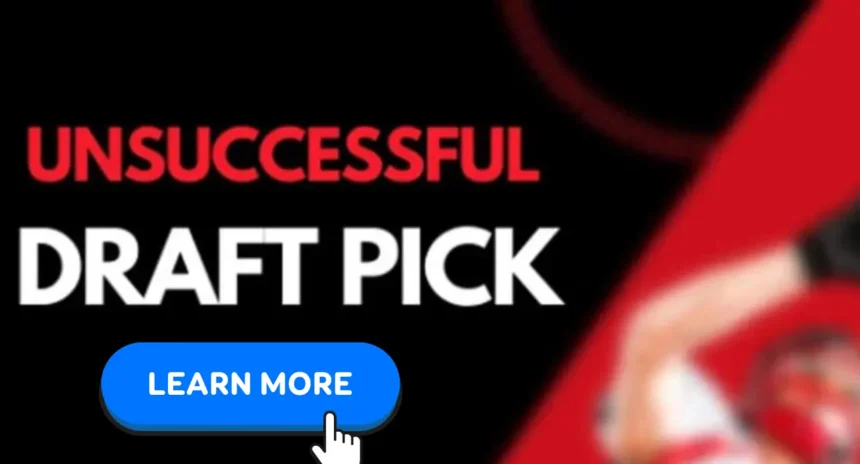Introduction to the draft pick and the team’s expectations
The excitement surrounding draft day can be electric. Teams invest time, resources, and hope into selecting the next big star. Fans eagerly await the announcement of their team’s picks, envisioning a future filled with championship glory.
Yet not every selection lives up to those lofty expectations. Some players become notorious for falling short of the potential that once shone brightly on them. Today, we dive into one such unsuccessful draft pick whose journey serves as a case study in what happens when talent doesn’t translate onto the field.
Through this exploration, we’ll uncover valuable lessons learned along the way—insights that can help teams make more informed decisions in future drafts. Let’s take a closer look at this intriguing story and see what went wrong.
The player’s background and scouting report
The player’s background painted a promising picture. Coming from a small town, he was known for his explosive speed and agility on the field. Coaches raved about his work ethic and dedication to the game.
During high school, he broke several records, showcasing not just talent but also an impressive drive to improve. His college years only solidified his reputation as a raw but gifted athlete.
Scouts flocked to see him play, often highlighting his potential in their reports. They noted that while he had exceptional physical attributes, there were concerns about consistency and decision-making under pressure.
Despite these red flags, teams viewed him as a diamond in the rough. Hopes ran high that with proper coaching and development, he could transform into a star player at the professional level.
On-field performance and initial struggles
The player burst onto the scene with high hopes. Yet, as the season unfolded, it became clear that things were not going as planned.
From missed tackles to dropped passes, every game seemed to highlight a new issue. Fans watched in disbelief as their once-promising rookie faltered under pressure. The speed of the professional league proved overwhelming.
Teammates tried to rally around him. Coaches offered guidance and adjustments during practice sessions. Still, progress was slow.
Each week brought mounting scrutiny from analysts and fans alike. Confidence waned, impacting his overall performance further. The initial excitement surrounding this draft pick started to fade into disappointment.
With each mistake, it became increasingly difficult for him to regain his footing on the field. What was supposed to be a breakthrough turned into a prolonged struggle that defined his early career.
Factors that contributed to the player’s lack of success
Various factors played a role in the player’s downfall. First, injuries plagued his early career. Those setbacks stunted his development and confidence.
Additionally, the pressure to perform weighed heavily on him. Expectations can be a double-edged sword; they can motivate but also overwhelm. The spotlight intensified as fans and analysts scrutinized every move he made.
Coaching decisions also impacted his performance. A lack of proper guidance or inconsistent strategies hindered his growth on the field.
Moreover, adapting to the pace of professional play proved challenging. Many talented players struggle with this transition, and it became evident that he was no exception.
Off-field distractions added more complexity to his situation. Balancing personal life with professional demands is tough for many athletes, ultimately affecting focus and dedication in games.
Impact on the team and potential missed opportunities
The impact of an unsuccessful draft pick can ripple through a team, affecting morale and strategy. Coaches often rely on new talent to fill gaps and elevate performance. When expectations fall flat, it sends shockwaves across the roster.
Players may feel pressure as they strive to compensate for missing contributions. Trust in management can wane, leading to questions about scouting accuracy. This uncertainty creates tension within locker rooms.
Moreover, missed opportunities extend beyond individual stats. The team might overlook other potential picks who could have made significant impacts elsewhere. These decisions shape future drafts and influence overall franchise direction.
As fans witness the fallout from these choices, frustration builds. Enthusiasm wanes when promising seasons are hindered by unmet expectations stemming from one draft selection gone wrong. It’s a complex interplay of factors that can redefine trajectories for both players and teams alike.
Lessons learned for future draft picks
Analyzing an unsuccessful draft pick reveals crucial insights for future selections. First, it’s essential to prioritize character and work ethic alongside talent. Raw skills can only take a player so far without the right mindset.
Scouting reports should focus on adaptability. Players who thrive in various situations tend to have longer careers. Relying too heavily on collegiate performance may overlook a player’s potential fit at the professional level.
Teams must enhance their support systems as well. A robust mentorship program can help new players navigate challenges and pressure.
It’s vital to be patient with development timelines. Rushing players into roles they’re not ready for often leads to disappointing results. Fostering an environment that encourages growth rather than immediate production is key for success in future drafts.
These lessons can shape stronger teams and more successful careers down the line.

Understanding the Unsuccessful Draft Pick
An Unsuccessful Draft Pick often becomes a topic of scrutiny for sports analysts, team management, and fans alike. These players, despite being selected with high expectations, may not meet performance standards or fit into the team’s strategy. To understand why a draft pick fails, it’s crucial to analyze the factors influencing their underperformance. This includes evaluating their skill set, adaptability to the team’s playstyle, and the potential mismatch between their abilities and the team’s needs.
Common Reasons for Draft Failure
Several factors contribute to an Unsuccessful Draft Pick. Common reasons include injuries, lack of proper development, or a poor fit within the team’s existing roster. Sometimes, the player’s performance in college or previous leagues may not accurately predict their success in a professional setting. Understanding these reasons helps teams refine their scouting and selection processes, minimizing the risk of future draft failures.
Impact on Team Strategy
An Unsuccessful Draft Pick can have significant implications for a team’s strategy and roster management. When a highly anticipated player fails to deliver, it can disrupt team dynamics and force management to make unexpected adjustments. This could involve reallocating resources, such as trades or additional scouting, to compensate for the lack of contribution from the draft pick. Analyzing these impacts provides insights into how teams can better align their drafting strategies with long-term goals.
Lessons from the Draft Process
Examining an Unsuccessful Draft Pick offers valuable lessons for improving the draft process. Teams can learn to refine their evaluation criteria, focusing not only on athletic performance but also on psychological factors, such as resilience and adaptability. Additionally, integrating more comprehensive data analysis and feedback from developmental leagues can enhance the accuracy of draft selections, reducing the likelihood of future failures.
Case Studies of Notable Failures
Studying notable examples of Unsuccessful Draft Picks provides practical insights into what went wrong and how similar mistakes can be avoided. Case studies of well-known draft failures highlight patterns and commonalities that can guide future decisions. By analyzing these cases, teams can identify red flags and better understand the complex interplay of factors that contribute to a draft pick’s success or failure.
Future Strategies for Avoiding Draft Pitfalls
To avoid repeating the mistakes of an Unsuccessful Draft Pick, teams should adopt forward-thinking strategies. This includes improving scouting methodologies, incorporating advanced analytics, and focusing on player development programs. By embracing a holistic approach that considers both player potential and team fit, organizations can enhance their chances of selecting players who will positively impact their roster and contribute to long-term success.
FAQ: Analyzing an Unsuccessful Draft Pick
- What is an unsuccessful draft pick?
An unsuccessful draft pick refers to a player selected in a draft who, despite high expectations or potential, fails to perform effectively or live up to the anticipated value. This can result from various factors such as injuries, poor fit within the team, or underperformance.
- What lessons can be learned from analyzing an unsuccessful draft pick?
Analyzing an unsuccessful draft pick provides valuable insights into improving future drafts. Key lessons include understanding the importance of thorough scouting, evaluating player fit with team needs, and the potential impact of injuries or off-field issues. It also highlights the need for adaptability in draft strategies.
- How can teams avoid making unsuccessful draft picks?
Teams can reduce the risk of making unsuccessful draft picks by implementing comprehensive scouting methods, using advanced analytics, considering player fit within the team’s system, and assessing players’ physical and mental readiness. Additionally, learning from past draft failures helps refine future draft strategies.
- Can an unsuccessful draft pick impact a team’s overall performance?
Yes, an unsuccessful draft pick can significantly impact a team’s performance. It may lead to missed opportunities to strengthen the roster, affect team morale, and influence future draft decisions. Evaluating these impacts helps teams adjust their approach to avoid similar pitfalls.
- What role do scouting reports play in the success of draft picks?
Scouting reports are crucial in assessing a draft pick’s potential and fit within a team. They provide detailed evaluations of a player’s skills, strengths, weaknesses, and overall potential. Accurate and thorough scouting helps teams make informed decisions and reduce the likelihood of selecting an unsuccessful draft pick.
- How can teams learn from the mistakes of past unsuccessful draft picks?
Teams can learn from past mistakes by conducting post-draft evaluations, analyzing the reasons behind the pick’s failure, and adjusting their scouting and drafting processes accordingly. Incorporating feedback and refining strategies based on previous experiences helps teams improve future draft outcomes.
Conclusion
Analyzing an unsuccessful draft pick can reveal much about the intricacies of player selection and team dynamics. The journey from anticipation to disappointment offers valuable insights that extend beyond just one player’s experience.
Lessons learned highlight the importance of thorough scouting, understanding a player’s fit within a team’s system, and considering off-field factors like work ethic and adaptability.
Every draft pick tells a story. Although some narratives may not end in success, they pave the way for future improvements in decision-making processes. Teams must continuously reflect on these experiences to refine their strategies moving forward.
Examining what went wrong helps foster growth for teams and players alike. Each unsuccessful draft pick serves as a reminder that talent alone does not guarantee success in professional sports; it’s about finding the right match between skillset and opportunity.
These reflections will help shape better outcomes in future drafts, ensuring that lessons resonate long after final selections are made.
_________________________________________________________________________________________
FAQ
Q1: What is considered an Unsuccessful Draft Pick?
A: An Unsuccessful Draft Pick refers to a player selected in a sports draft who fails to meet expectations, either due to poor performance, injury, or an inability to adapt to the professional level. Despite being chosen with high hopes, these players may not contribute significantly to their team’s success.
Q2: What factors contribute to an Unsuccessful Draft Pick?
A: Several factors can contribute to an Unsuccessful Draft Pick, including overestimating a player’s potential, injuries, poor fit with the team’s system, lack of development, and sometimes off-field issues. In many cases, external pressures or inaccurate scouting reports can also lead to poor draft choices.
Q3: How can teams avoid Unsuccessful Draft Picks?
A: Teams can minimize the risk of an Unsuccessful Draft Pick by improving their scouting and evaluation processes, focusing on a player’s long-term potential, and considering factors like work ethic, adaptability, and team culture fit. It’s also essential to take into account both the physical and mental attributes of players.
Q4: Can an Unsuccessful Draft Pick still become a valuable player?
A: Yes, while some Unsuccessful Draft Picks may struggle initially, they can still turn their careers around through hard work, development, and sometimes a change of environment. Many players have overcome early setbacks to eventually succeed in the league, proving that draft status is not always the final indicator of a player’s career.
Q5: What lessons are learned from analyzing an Unsuccessful Draft Pick?
A: The article highlights that lessons learned from an Unsuccessful Draft Pick include the importance of thorough player evaluation, understanding team needs, and the unpredictability of talent development. It also stresses that teams should not rely solely on a player’s college or amateur performance but rather focus on their potential in a professional environment.
Q6: Are Unsuccessful Draft Picks common in professional sports?
A: Yes, Unsuccessful Draft Picks are quite common in all professional sports. Even with advanced scouting and analytics, predicting a player’s future performance in a professional league is challenging, and many top prospects fail to live up to their pre-draft expectations.
Q7: How do teams recover from an Unsuccessful Draft Pick?
A: Teams can recover from an Unsuccessful Draft Pick by focusing on player development, making smart trades, or acquiring talent through free agency. Learning from past mistakes in the draft process can also help improve future selections and overall team strategy.
Q8: Can fan expectations influence whether a draft pick is considered unsuccessful?
A: Absolutely. Fan expectations often play a role in determining whether a draft pick is seen as successful or not. High draft picks typically carry greater expectations, and if a player does not live up to those, even marginal underperformance can lead to the label of an Unsuccessful Draft Pick.
Q9: What impact does an Unsuccessful Draft Pick have on a team’s future?
A: An Unsuccessful Draft Pick can have a lasting impact on a team, especially if it was a high pick in the draft. It can set back a team’s rebuilding efforts, cause roster gaps, and limit cap flexibility. However, teams that learn from these experiences can adjust their draft strategy to improve future selections.










